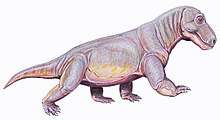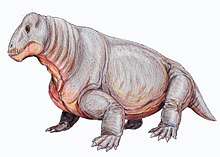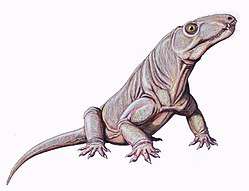Estemmenosuchus
Estemmenosuchus (meaning "crowned crocodile" in Greek) is an extinct genus of large, early omnivorous therapsids. It is believed and interpreted to have lived during the middle part of the Middle Permian around 267 million years ago. The two species, E. uralensis and E. mirabilis, are characterised by distinctive horn-like structures, which were probably used for intra-specific display. Both species of Estemmenosuchus are from the Perm (or Cis-Urals) region of Russia. Two other estemmenosuchids, Anoplosuchus and Zopherosuchus, are now considered females of the species E. uralensis.[1] There were many complete and incomplete skeletons found together.
| Estemmenosuchus | |
|---|---|
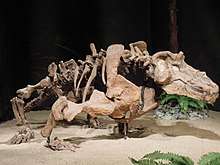 | |
| E. uralensis skeleton | |
| Scientific classification | |
| Kingdom: | Animalia |
| Phylum: | Chordata |
| Clade: | Therapsida |
| Suborder: | †Dinocephalia |
| Family: | †Estemmenosuchidae |
| Genus: | †Estemmenosuchus Tchudinov, 1960 |
| Species | |
| |
| Synonyms | |
| |
Description
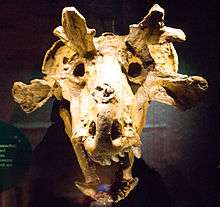
Estemmenosuchus could reach a body length of more than 3 m (10 ft).[2] Its skull was long and massive, up to 65 cm (26 in) in length,[2] and possessed several sets of large horns, somewhat similar to the antlers of a moose, growing upward and outward from the sides and top of the head. The animal had a sprawling posture as indicated by analysing its shoulder joints.
The skull superficially resembles that of Styracocephalus, but the "horns" are formed from different bones; in Estemmenosuchus the horns are located on the frontals and protrude upward, whereas in Styracocephalus the horns are formed by the tabular and extend aft.
Species
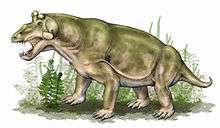
Estemmenosuchus is interpreted to have lived some 267 million years ago. Two species have been identified, from the Ocher Assemblage Zone Belebei Formation at the Ezhovo locality near Ochyor in the Perm region of the Russia in 1960. They were found with the Biarmosuchians Eotitanosuchus olsoni and Biarmosuchus tener in channel flood deposits of the young Ural Mountains. They differ in size, shape of the skull, and shape of the horns.
Originally all specimens were included in Estemmenosuchus uralensis, but it was since realised that there were a number of different species. However, not all palaeontologists agree that these were different species. According to Ivakhnenko (1998) Anoplosuchus and Zopherosuchus are synonyms of Estemmenosuchus uralensis.[3]
| Species | Status | Abundance[3] | Remains[3] | Skull length | Body Length[3] | Notes | Images |
|---|---|---|---|---|---|---|---|
| Anoplosuchus tenuirostris | Synonym of Estemmenosuchus uralensis | Fairly uncommon | Incomplete skeleton and skull | Intermediate in size | There are no horns or thickening, except in the front nasal region.[3] | ||
| Estemmenosuchus mirabilis | Valid species | Fairly uncommon | Skull, lower jaw and vertebrae | Up to 42 cm long | 3 m long | Unlike E. uralensis, which had only one horn on each side of its head, this species had 2 projecting bony knobs on each side of the cranium, one on the top pointing up looking like antlers and another pointing to the side similar to E. uralensis. Its snout is smaller and wider than its relative and looks vaguely like a modern moose. The palate teeth include six incisors, two canines and about twenty small incisor-like teeth at the rear. The lower palate contained six incisors, two canines and about thirty smaller back teeth. |  |
| Estemmenosuchus uralensis | Valid species | Common | Elements of skulls and postcrania | Up to 68 cm long | 4.5 m long | The species are characterised by horns which project upward and outward on the side of the head. The mouth contained large canines with small molar teeth. | .jpg) |
| Zopherosuchus luceus | Synonym of Estemmenosuchus uralensis | Fairly uncommon | Poorly preserved skeleton and incomplete skull | 1.5 m long | Some of bones at the front of the skull are particularly thickened.[3] | ||
Paleobiology
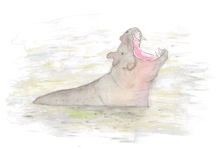
Thermoregulation
It has been suggested that the animal had a fairly constant internal temperature. Its large size and compact build gave a small surface-to-volume ratio and suggests it would not gain (or lose) temperature quickly. This phenomenon is called gigantothermy and was probably an important factor in temperature regulation in most therapsids.[4]
Skin
P. Chudinov reported skin impressions belonging to Estemmenosuchus in 1968. The skin was described as being "glandular" like that of a hairless mammal or a frog.[5]
References
- Ivakhnenko, M.F. (2000). "Estemmenosuchus and primitive theriodonts from the Late Permian". Paleontological Journal. 34 (2): 184–192.
- Ivakhnenko, M. F. (2001). "Tetrapods from the East European Placket—Late Paleozoic Natural Territorial Complex". Proceedings of the Paleontological Institute of the Russian Academy of Sciences (in Russian). 283: 200.
- "Therapsida: Dinocephalia: Estemmenosuchidae". Palaeos. Retrieved 23 October 2015.
- Ruben, J.A.; Jones, T.D. (2000). "Selective Factors Associated with the Origin of Fur and Feathers" (PDF). Am. Zool. 40: 585–596. doi:10.1093/icb/40.4.585.
- "Getting to the Root of Fur". National Geographic. October 10, 2014. Retrieved November 1, 2018.
Further reading
- Chudinov, P. K. 1965, "New Facts about the Fauna of the Upper Permian of the USSR", Journal of Geology, 73:117-30
- King, Gillian M., "Anomodontia" Part 17 C, Encyclopedia of Paleoherpetology, Gutsav Fischer Verlag, Stuttgart and New York, 1988
- Olsen, E. C., 1962, Late Permian terrestrial vertebrates, USA and USSR Transactions of the American Philosophical Society, new series, 52:1–224
- Patricia Vickers-Rich and Thomas H. Rich, The Great Russian Dinosaurs, Guntar Graphics, 1993, p. 30
External links
- Palaeos - detailed description
